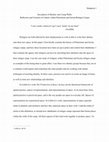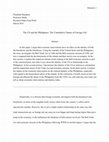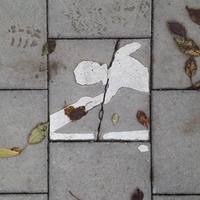Drafts by Elizabeth Hampson

Refugees are both affected by their displacement as well as able to write their identity onto the... more Refugees are both affected by their displacement as well as able to write their identity onto their new space. In this paper, I first briefly examine the history of Palestinian and Syrian refugee camps, and how these locations have been set up to police and control their inhabitants. I then examine the agency that refugees can have by inscribing their identities onto the space of their refugee camp. I use the case study of refugees within Palestinian and Syrian refugee camps as examples of this being done to great effect. I use these two identity groups because they are in a common world region (and sometimes the same people) and are working with similar techniques of asserting identity. In these cases, practices are used to recreate an image of home, as well as form new relationships and identities. In Lefebvre's work The Production of Space, he lays out his theoretical framework of spatial practice, spaces of representation, and representations of space. At its most basic form, spatial practice is perceived space, and is the way people use space in everyday life. Spaces of representation are experienced space. In Lefebvre's work, representations of space typically relate to planners and architects and how they represent space in their work. I add the realm of artists to this definition, to include how inhabitants of refugee camps represent their home places within the walls of the camp. All three aspects of this triad work together to produce space. In 1 Lefebvre, 40-43.

In this paper, I argue that economic interventions have an effect ... more In this paper, I argue that economic interventions have an effect on the identity of both the benefactor and the benefactee. Using the example of the United States and the Philippines, the essay investigates the Bell Trade Act of 1946 and the Bell economic mission of 1950, and how it negated both the decolonization of the islands and their newly-won sovereignty. In the first section, I explore the empirical referent itself, looking at the Bell economic mission as part of the colonized past, and what it says about the identity of the US in relationship to the Philippines. In the second section, I deconstruct the identity of the US in relation to colonialism and the imperialist nature of the Trade Act and economic mission. In the third section, I explore the impact of the economic intervention on the cultural identity of the Philippines, especially with regard to the hierarchical nature of the islands. In the conclusion, I briefly touch on how the foreign aid affected the future of the Philippines from the 1950's on, and what this case study can tell us about economic interventions and identity today. ______________________________________________________________________________ Empirically, it is obvious that foreign economic aid impacts both the benefactor and benefactee; in terms of the tangible result, money shifts from one country's coffers and is injected into another. However, this is not a simple market relationship in the same way that trade transactions are, as foreign aid can cause an even bigger and long-lasting impact than just a jump in the economy; it also influences the identities of both nations involved. The Bell Trade Act and economic mission in the Philippines following WWII reveal this impact. I argue that the
Memorialization is what brands history into our minds; standing in front of a statue or monument ... more Memorialization is what brands history into our minds; standing in front of a statue or monument can be a powerful moment to make us think of the past. Through different placemaking practices, natives and settlers were in a constant push back and forth over claim to land and belonging. In the public eye, the colonists' idea of place overrode that of the native groups and still does to this day, as Narragansett memorializations are often overlooked by non-native observers. Because of this, it is important to look at Narragansett archaeological sites, historical records, and modern practices to get a better sense of their idea of place and the history of Rhode Island.









Uploads
Drafts by Elizabeth Hampson